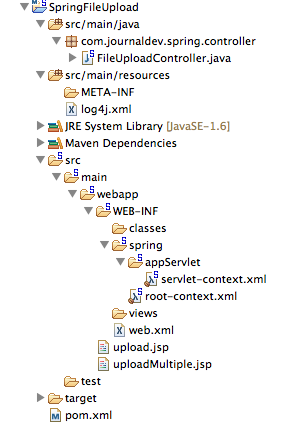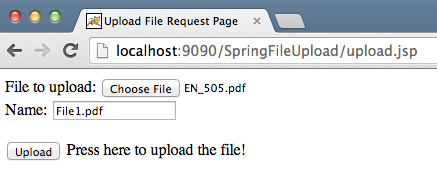文件上传是任何Web应用程序中非常常见的任务。我们之前介绍过如何在Servlet中上传文件和Struts2文件上传。今天我们将学习Spring文件上传,特别是Spring MVC文件上传,支持单个和多个文件。
Spring MVC文件上传
Spring MVC框架通过集成Apache Commons FileUpload API提供了对文件上传的支持。上传文件的过程非常简单,只需进行简单的配置。我们将在STS中创建一个简单的Spring MVC项目,如下图所示。 大部分是由STS工具生成的样板代码,我们将专注于需要进行的更改,以利用Spring文件上传集成。
大部分是由STS工具生成的样板代码,我们将专注于需要进行的更改,以利用Spring文件上传集成。
Apache Commons FileUpload的Maven依赖
首先,我们需要在我们的pom.xml文件中添加Apache Commons FileUpload的依赖,以便将所需的jar文件纳入Web应用程序。以下是我的pom.xml文件中的依赖片段。
<!-- Apache Commons FileUpload -->
<dependency>
<groupId>commons-fileupload</groupId>
<artifactId>commons-fileupload</artifactId>
<version>1.3.1</version>
</dependency>
<!-- Apache Commons IO -->
<dependency>
<groupId>commons-io</groupId>
<artifactId>commons-io</artifactId>
<version>2.4</version>
</dependency>
Spring文件上传表单视图
我们将创建两个JSP页面,以允许在Spring Web应用程序中进行单个和多个文件上传。 upload.jsp视图代码:
<%@ taglib uri="https://java.sun.com/jsp/jstl/core" prefix="c" %>
<%@ page session="false" %>
<html>
<head>
<title>Upload File Request Page</title>
</head>
<body>
<form method="POST" action="uploadFile" enctype="multipart/form-data">
File to upload: <input type="file" name="file"><br />
Name: <input type="text" name="name"><br /> <br />
<input type="submit" value="Upload"> Press here to upload the file!
</form>
</body>
</html>
uploadMultiple.jsp视图代码:
<%@ taglib uri="https://java.sun.com/jsp/jstl/core" prefix="c" %>
<%@ page session="false" %>
<html>
<head>
<title>Upload Multiple File Request Page</title>
</head>
<body>
<form method="POST" action="uploadMultipleFile" enctype="multipart/form-data">
File1 to upload: <input type="file" name="file"><br />
Name1: <input type="text" name="name"><br /> <br />
File2 to upload: <input type="file" name="file"><br />
Name2: <input type="text" name="name"><br /> <br />
<input type="submit" value="Upload"> Press here to upload the file!
</form>
</body>
</html>
请注意,这些文件是简单的HTML文件,我没有使用任何JSP或Spring标签以避免复杂性。需要注意的重要一点是表单enctype应为multipart/form-data,以便Spring Web应用程序知道请求包含需要处理的文件数据。还请注意,对于多个文件,表单字段“file”和“name”在输入字段中是相同的,以便数据将以数组形式发送。我们将获取输入数组并解析文件数据,然后将其存储在给定的文件名中。
Spring MVC 多部分配置
要利用Apache Commons FileUpload处理多部分请求,我们只需要配置multipartResolver bean,其类为org.springframework.web.multipart.commons.CommonsMultipartResolver。我们的最终Spring配置文件如下。servlet-context.xml 代码:
<?xml version="1.0" encoding="UTF-8"?>
<beans:beans xmlns="https://www.springframework.org/schema/mvc"
xmlns:xsi="https://www.w3.org/2001/XMLSchema-instance" xmlns:beans="https://www.springframework.org/schema/beans"
xmlns:context="https://www.springframework.org/schema/context"
xsi:schemaLocation="https://www.springframework.org/schema/mvc https://www.springframework.org/schema/mvc/spring-mvc.xsd
https://www.springframework.org/schema/beans https://www.springframework.org/schema/beans/spring-beans.xsd
https://www.springframework.org/schema/context https://www.springframework.org/schema/context/spring-context.xsd">
<!-- DispatcherServlet Context: defines this servlet's request-processing
infrastructure -->
<!-- Enables the Spring MVC @Controller programming model -->
<annotation-driven />
<!-- Handles HTTP GET requests for /resources/** by efficiently serving
up static resources in the ${webappRoot}/resources directory -->
<resources mapping="/**" location="/" />
<!-- Resolves views selected for rendering by @Controllers to .jsp resources
in the /WEB-INF/views directory -->
<beans:bean
class="org.springframework.web.servlet.view.InternalResourceViewResolver">
<beans:property name="prefix" value="/WEB-INF/views/" />
<beans:property name="suffix" value=".jsp" />
</beans:bean>
<beans:bean id="multipartResolver"
class="org.springframework.web.multipart.commons.CommonsMultipartResolver">
<!-- setting maximum upload size -->
<beans:property name="maxUploadSize" value="100000" />
</beans:bean>
<context:component-scan base-package="com.journaldev.spring.controller" />
</beans:beans>
请注意,我通过为multipartResolver bean 提供maxUploadSize 属性值来设置最大上传大小限制。如果您查看DispatcherServlet类的源代码,您会发现下面的方法中定义并初始化了一个名为multipartResolver的MultipartResolver变量。
private void initMultipartResolver(ApplicationContext context)
{
try
{
this.multipartResolver = ((MultipartResolver)context.getBean("multipartResolver", MultipartResolver.class));
if (this.logger.isDebugEnabled()) {
this.logger.debug("Using MultipartResolver [" + this.multipartResolver + "]");
}
}
catch (NoSuchBeanDefinitionException ex)
{
this.multipartResolver = null;
if (this.logger.isDebugEnabled())
this.logger.debug("Unable to locate MultipartResolver with name 'multipartResolver': no multipart request handling provided");
}
}
通过这个配置,任何 enctype 为 multipart/form-data 的请求都会在传递给控制器类之前由 multipartResolver 处理。
Spring 文件上传控制器类
控制器类代码非常简单,我们需要为uploadFile和uploadMultipleFile URI 定义处理程序方法。FileUploadController.java 代码:
package com.journaldev.spring.controller;
import java.io.BufferedOutputStream;
import java.io.File;
import java.io.FileOutputStream;
import org.slf4j.Logger;
import org.slf4j.LoggerFactory;
import org.springframework.stereotype.Controller;
import org.springframework.web.bind.annotation.RequestMapping;
import org.springframework.web.bind.annotation.RequestMethod;
import org.springframework.web.bind.annotation.RequestParam;
import org.springframework.web.bind.annotation.ResponseBody;
import org.springframework.web.multipart.MultipartFile;
/**
* Handles requests for the application file upload requests
*/
@Controller
public class FileUploadController {
private static final Logger logger = LoggerFactory
.getLogger(FileUploadController.class);
/**
* Upload single file using Spring Controller
*/
@RequestMapping(value = "/uploadFile", method = RequestMethod.POST)
public @ResponseBody
String uploadFileHandler(@RequestParam("name") String name,
@RequestParam("file") MultipartFile file) {
if (!file.isEmpty()) {
try {
byte[] bytes = file.getBytes();
// 创建用于存储文件的目录
String rootPath = System.getProperty("catalina.home");
File dir = new File(rootPath + File.separator + "tmpFiles");
if (!dir.exists())
dir.mkdirs();
// 在服务器上创建文件
File serverFile = new File(dir.getAbsolutePath()
+ File.separator + name);
BufferedOutputStream stream = new BufferedOutputStream(
new FileOutputStream(serverFile));
stream.write(bytes);
stream.close();
logger.info("Server File Location="
+ serverFile.getAbsolutePath());
return "You successfully uploaded file=" + name;
} catch (Exception e) {
return "You failed to upload " + name + " => " + e.getMessage();
}
} else {
return "You failed to upload " + name
+ " because the file was empty.";
}
}
/**
* Upload multiple file using Spring Controller
*/
@RequestMapping(value = "/uploadMultipleFile", method = RequestMethod.POST)
public @ResponseBody
String uploadMultipleFileHandler(@RequestParam("name") String[] names,
@RequestParam("file") MultipartFile[] files) {
if (files.length != names.length)
return "Mandatory information missing";
String message = "";
for (int i = 0; i < files.length; i++) {
MultipartFile file = files[i];
String name = names[i];
try {
byte[] bytes = file.getBytes();
// 创建用于存储文件的目录
String rootPath = System.getProperty("catalina.home");
File dir = new File(rootPath + File.separator + "tmpFiles");
if (!dir.exists())
dir.mkdirs();
// 在服务器上创建文件
File serverFile = new File(dir.getAbsolutePath()
+ File.separator + name);
BufferedOutputStream stream = new BufferedOutputStream(
new FileOutputStream(serverFile));
stream.write(bytes);
stream.close();
logger.info("Server File Location="
+ serverFile.getAbsolutePath());
message = message + "You successfully uploaded file=" + name
+ "
";
} catch (Exception e) {
return "You failed to upload " + name + " => " + e.getMessage();
}
}
return message;
}
}
请注意使用了Spring注解,使我们的生活更轻松,代码看起来更易读。uploadFileHandler 方法用于处理单个文件上传场景,而 uploadMultipleFileHandler 方法用于处理多个文件上传场景。实际上,我们可以有一个单一的方法来处理这两种情况。现在将应用程序导出为WAR文件并部署到Tomcat servlet容器中。当我们运行我们的应用程序时,下面的图像显示了请求和响应。

















